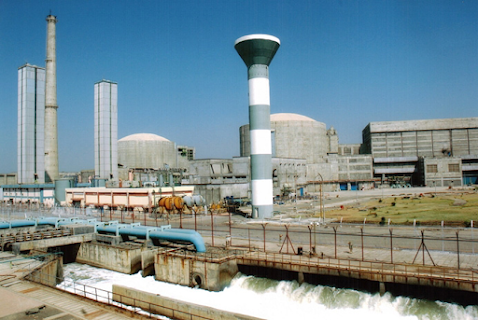ZERO EMISSION ATOMIC ENERGY: The Future of Energy Generation & Storage Series
ZERO EMISSION ATOMIC ENERGY
Haven’t
we all thought of an ideal form of energy to run the world; one which would be
clean & also more efficient? There exists such a source of energy: the
zero-emission energy – Atomic energy.
TARAPUR ATOMIC POWER STATION
Atomic
energy is a clean energy source with high reliability and high energy density. It
has one of the smallest carbon footprints and may be our answer to positively
impacting climate change and greenhouse gas emissions. Some experts take a step
forward to even say that it is a contestant as one of our answers for the
energy gap.
But what exactly is atomic energy, the one
solution to all our problems?
Atomic
energy or nuclear energy is the energy that is released in significant amount
through the processes that affect the atomic nuclei, the dense cores of the
atom housing protons and neutrons. The
two ways to release this energy are nuclear fission: where one larger atomic
nucleus splits into two smaller atomic nuclei, and, nuclear fusion: where two
smaller atomic nuclei fuse to form one larger atomic nucleus. Until now, around
the world only nuclear fission is used to obtain atomic energy in nuclear power
plants.
What is the fuel used for this process of
generating the atomic energy and how is it obtained?
AUTUNITE: CALCIUM URANIUM PHOSPHATE-URANIUM ORE
Uranium
is the most common fuel used to produce electricity by atomic means around the
world. It is a metal found very commonly in earth in the firm of its ores. The
popularity of the uranium as a fuel comes from the fact that its atomic nucleus
splits easily to produce two daughter nuclei. Six countries that are major producers of
uranium are Kazakhstan, Canada, Australia, Namibia, Niger & Russia. The
uranium ore is mined, crushed and then chemically treated to separate uranium
in a process called milling. Uranium Oxide [U3O8] in
a powdered form is obtained and is known as yellowcake. Yellowcake is the form
of uranium suitable for enrichment.
What is this enrichment and why is it required?
Uranium has three natural isotopes: U-235, U-238 and U-234. Out of these only U-235 is the only isotope that can undergo fission and maintain nuclear reactor’s chain reaction. Unfortunately, it accounts for only 0.71% of natural uranium. The uranium oxide from the yellowcake is to be converted to uranium hexafluoride [UF6] gas. The process of increase the percentage of U-235 to 3% to 5% in the given uranium sample is known as uranium enrichment. To do this, the UF6 gas is introduced into high velocity centrifuges, where the heavier isotopes are pushed outwards. Enriched UF6 is converted to U3 O8 which is then converted to small, solid cylindrical pellets. These pellets are packed in metal rods and then grouped into fuel assemblies.
How exactly is the electricity produced from these fuel assemblies?
A
reactor core is made of hundreds or more fuel assemblies depending upon the
power level. Inside this reactor core the rods are immersed in water which will
act both as coolant and also as a moderator. The moderator or a moderating
medium helps to slow down the neutrons produced by fission to sustain the chain
reaction. These rods can then be inserted into the reactor core to reduce the
reaction rate or withdrawn to increase the rate. There is a heat release
accompanying the fission reaction in the rods. This heat energy is used to
produce steam which is then used to turn the turbines to produce carbon free
electricity.
URANIUM FUEL ASSEMBLIES
A singular fuel assembly is typically used to reactor cores for two or three years after which it is removed and stored under water which provides both cooling and radiation shielding.
How does this fission reaction occur?
When
a U-235 nucleus absorbs an extra neutron, it quickly breaks into two parts.
Each time a U-235 nucleus splits, it releases an extra 2 or 3 neutrons. The
release of these neutrons gives a possibility for chain reaction wherein these
processes would continue without any external addition of neutrons.
What is done with the spent fuel assemblies?
The
spent nuclear fuel assemblies are initially stored in steel lined concrete
pools surrounded by water. It’s later removed from the pools and placed into
dry storage cask that are made of steel and concrete or other materials used
for protective shielding.
There
is no permanent way to dispose off the spent fuel assemblies. This is because,
it stays radioactive for a long time before decaying to stability. However,
this can never be out in open and exposed to environment because it will emit
harmful radiation.
Why is Nuclear Fusion not used for energy generation?
Nuclear fusion is the process that powers
stars like the Sun. In the Sun’s core, two hydrogen nuclei fuse to form one
helium nucleus. In accordance with Einstein’s theory of relativity and the
famous equation E=mc2 , there is tremendous amount of energy
released.
There are a few challenges in harnessing this technology. In the stars, massive gravitational fields create right environment for the fusion process but these are harder to achieve here on the Earth. The fusion fuel – a mix of isotopes of the Hydrogen – must be heated to extreme temperatures (those in the order of 50 million degree Celsius, the temperature closer to the core of Sun), and be contained under extremely high pressures for long enough interval for the nuclei to fuse. These will eventually lead to a self -sustaining nuclear rection where only the fuel will have to be added later on. This reaction will give energy to four tomes the one given by nuclear fission reaction.
But
the challenges lie in the fact that these extreme conditions are very hard to
obtain and even more difficult to sustain.
There
is research going on for the development of fusion reactors, and it is safe to
say the one day we will have a self-sustaining, clean and efficient source of
energy to run all of our technology.
Credits: Anushka
Deobhankar- Tech Tuesday COEP Blogs
References:
- https://www.duke-energy.com/energy-education/how-energy-works/nuclear-power#:~:text=Nuclear%20energy%20originates%20from%20the,not%20produce%20greenhouse%20gas%20emissions.
- https://www.youtube.com/watch?v=2W4v5_ZVQOA
- https://world-nuclear.org/information-library/current-and-future-generation/nuclear-fusion-power.aspx
- https://www.iaea.org/newscenter/news/what-is-nuclear-energy-the-science-of-nuclear-power#:~:text=Nuclear%20energy%20is%20a%20form,fusion%20%E2%80%93%20when%20nuclei%20fuse%20together
- https://www.edfenergy.com/energywise/what-are-advantages-nuclear-energy#:~:text=Uranium%20is%20the%20raw%20material,term%20and%20low%2Dcarbon%20option







Comments
Post a Comment